Panel 1
Lorenzo Ciccarese, Roberto Daffinà, Valerio Silli
n 2023, organic farming in Italy covered 2,456,020 hectares, involving approximately 94,400 organic operators. Organic agriculture accounted for 7.4% of all farms and 19.8% of the utilised agricultural area (UAA), according to the 2021 ISTAT Census, falling 5.2 percentage points short of the 25% UAA target for organic farming.
Over the past 33 years, the trend has been upward in both the number of operators and cultivated area, countering the long-standing decline in utilised agricultural area in Italy.
At the European level, Italy ranks among the most virtuous Member States.
The indicator describes, at national and regional levels, the number of operators engaged in organic farming in accordance with a specific EU Regulation, the corresponding utilised agricultural area (UAA), and the relevant crops and livestock. It also reports the share of UAA used for organic farming across EU Member States.
This indicator provides a measure of the degree to which the Italian agricultural system has adopted organic and thus sustainable agronomic practices, aimed at ensuring environmental quality, biodiversity conservation, food safety, and animal welfare. At the European level, the indicator supports monitoring progress toward the objectives set out in the 8th Environment Action Programme (EAP), the EU Biodiversity Strategy for 2030, the Farm to Fork Strategy under the European Green Deal, and the UN 2030 Agenda for Sustainable Development. At the national level, the indicator is linked to Specific Objective III.7 of Italy’s National Strategy for Sustainable Development (approved in December 2017 by the Interministerial Committee for Economic Planning), which aims to “Ensure the sustainability of agriculture and forestry along the entire supply chain,” using the share of agricultural area under organic farming as a key metric. This indicator also contributes to the overall monitoring of the National Strategic Plan for the Development of Organic Agricultural Systems, approved in April 2016 by the State-Regions Conference
- Regulation (EU) 446/2019 – Amending Regulation (EU) 848/2018 regarding organic production and labelling of organic products.
- Regulation (EU) 848/2018 – Establishes the legal framework for organic production and repeals Regulation (EC) 834/2007, introducing harmonised rules for the certification, labelling, and control of organic products.
- Council Regulation (EC) 834/2007 – Sets out the objectives and principles of organic farming and lays the foundation for organic product labelling and imports (now repealed).
- Commission Regulation (EC) 889/2008 – Provides detailed rules for the implementation of Regulation (EC) 834/2007 on organic production, labelling, and control (now repealed).
- Commission Regulation (EC) 1235/2008 – Lays down rules for importing organic products from third countries.
- Ministerial Decree MASAF (formerly MiPAAF) No. 6793 of 18 July 2018 – Establishes national implementing provisions for Regulations (EC) 834/2007 and 889/2008; replaces Decree No. 18354 of 27 November 2009.
- Legislative Decree No. 20 of 23 February 2018 – Provides national legal structure supporting organic production and control systems in Italy.
- EU Farm to Fork Strategy – COM(2020) 381 final of 20 May 2020 – Calls for 25% of EU agricultural land to be under organic farming by 2030.
- EU Biodiversity Strategy for 2030 – COM(2020) 380 final of 20 May 2020 – Integrates organic farming targets as part of biodiversity conservation goals.
- COM(2022) 357 final of 26 July 2022 – Reinforces actions under the Green Deal related to food systems and biodiversity.
- Decision (EU) 2022/591 of 6 April 2022 – Establishes the EU’s 8th Environment Action Programme (EAP) to guide environmental policy until 2030.
-
Law No. 23 of 9 March 2022 – Governs the protection, development, and competitiveness of organic agricultural, agri-food, and aquaculture production in Italy.
Agriculture is recognised as organic if it complies with Council Regulation (EC) No 834/2007, which established a comprehensive framework for the organic production of crops and livestock, as well as for the labelling, processing, and marketing of organic products, including rules governing the import of organic products into the EU. The implementation rules for this Regulation are laid down in Commission Regulation (EC) No 889/2008.
The European Union’s “Farm to Fork Strategy – Our food, our health, our planet, our future” [COM(2020) 381 final of 20 May 2020] and the EU Biodiversity Strategy for 2030 [COM(2020) 380 final of 20 May 2020] both call for an increase in organic agricultural area across the EU, specifically aiming to reach at least 25% of EU agricultural land under organic farming by 2030.
The post-2020 Common Agricultural Policy (CAP) has been adapted to ensure that national Strategic Plans fully reflect the ambition of the European Green Deal and the Farm to Fork Strategy, by promoting sustainable practices such as precision farming, organic agriculture, agroecology, agroforestry, and stricter animal welfare standards, while rewarding farmers for their environmental and climate performance. In fact, Italy’s National Strategic Plan for the CAP 2023–2027, which is more ambitious than the EU-level target set for 2030, has established a national goal of 25% of agricultural land under organic farming by 2027.
Panel 2
CREA - SINAB, 2024, BIOREPORT 2024, https://www.sinab.it/sites/default/files/2024-07/BIo%20in%20cifre%202024.pdf
ISTAT, 7° Censimento Generale Agricoltura ISTAT, https://www.istat.it/notizia/censimento-agricoltura-2020-online-i-principali-dati/
Willer Helga, Schlatter Bernhard, Trávníček Jan, 2023, The World of Organic Agriculture Statistics and Emerging Trends 2023, Research Institute of Organic Agriculture FiBL and IFOAM, https://www.fibl.org/fileadmin/documents/shop/1254-organic-world-2023.pdf
The indicator provides only a partial measure of the extent to which agronomic practices conducive to high environmental quality, food safety, and animal welfare have been adopted, as it focuses exclusively on practices certified under the organic farming method, rather than encompassing the broader range of sustainable and low-impact agricultural practices.
For a more accurate estimate of the degree to which agronomic practices aimed at environmental and biodiversity protection, food safety, and animal welfare are being adopted, analyses and meta-analyses would be useful to demonstrate their positive effects—specifically in terms of biodiversity conservation, climate change mitigation and adaptation, soil quality, and the reduction of greenhouse gas and pollutant emissions.
Data quality assessment
EUROSTAT (Ufficio Statistico delle Comunità Europee)
ISTAT (Istituto Nazionale di Statistica)
MASAF (Ministero dell’Agricoltura, della Sovranità alimentare e delle Foreste)
SINAB (Sistema di Informazione Nazionale sull'Agricoltura Biologica)
SINAB, https://www.sinab.it/bio-statistiche/navigazione-banca-dati
EUROSTAT, https://ec.europa.eu/eurostat/databrowser/view/sdg_02_40/default/table?lang=en&category=sdg.sdg_02
ISTAT, https://esploradati.istat.it/databrowser/#/it/censimentoagricoltura
EU27, country-level, Regional
1990-2023
Indicator assessment
The data presented are the result of an analysis carried out by SINAB—a project of MASAF (formerly MiPAAF) managed by ISMEA and CIHEAM Bari—based on information as of 31 December 2023, provided by control bodies, regional administrations, and the Organic Information System. The control bodies authorised to certify compliance with the organic farming method report to MASAF, via the dedicated EUROSTAT questionnaire, the total organic area of all farms under their supervision. This area, disaggregated at the regional level, includes detailed information on all cropping systems and the main crop types (97 categories).
ccording to the latest EUROSTAT revision (2022), Italy ranks among the European countries with the highest share of agricultural land dedicated to organic farming (Figure 1). Based on data provided by control bodies operating in the organic farming sector in Italy and by regional administrations to the Ministry of Agriculture, Food Sovereignty and Forests, in 2023 the total organic and in-conversion area amounted to 2,456,020 hectares, marking a 4.5% increase compared to 2022. The number of organic operators reached 94,441, up by 1.8% (Figure 2). Relative to the total cultivated area in Italy (ISTAT Census 2021), organic farming now accounts for 19.8% of the national utilised agricultural area (UAA) and 7.4% of all farms (i.e. producers – Figure 4).
In 2023, with 19.8% of UAA under organic farming, Italy was just 5.2 percentage points short of the EU target of at least 25% of agricultural land managed organically by 2030. Through the actions of PANBio 2024–2026 (National Action Plan for Organic Production and Organic Products) and the National Strategic Plan for the CAP 2023–2027, Italy aims to reach this target by 2027, ahead of the EU deadline.
Since 1990, organic farming in Italy has grown significantly. In particular, since 2010, both the utilised agricultural area (UAA) and the number of organic operators have doubled (Figure 2).
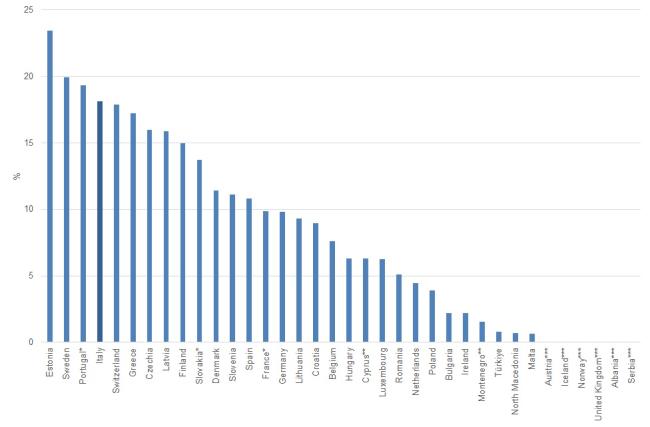

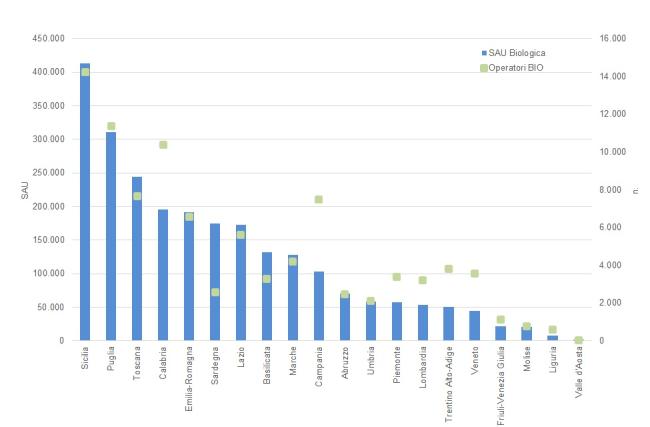
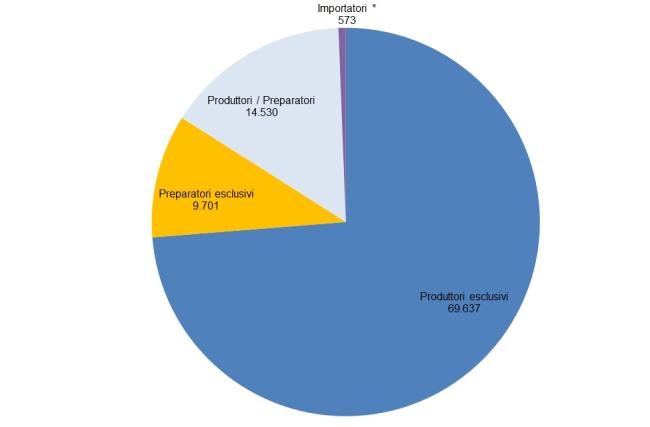
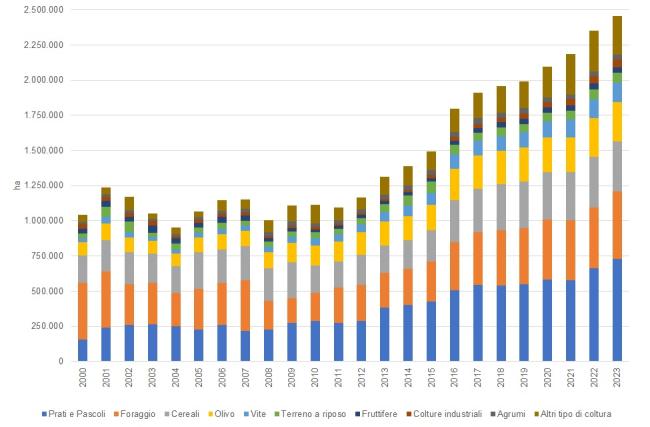
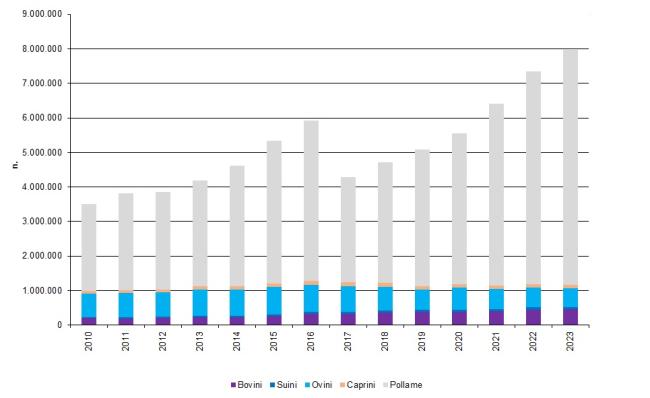
In 2023, the average size of an organic farm (i.e. producers – Figure 4) in Italy was 29 hectares, compared to the national average of 11 hectares (ISTAT Census 2021). Overall, Italian organic farming is concentrated in five regions—Sicily, Apulia, Tuscany, Calabria, and Emilia-Romagna—which together account for 55% of the national organic agricultural area and 53% of organic operators (Figure 3). Notably, the regions of Tuscany, Calabria, Sicily, Marche, Basilicata, and Lazio have already converted at least 25% of their agricultural land to organic production.
As for crop types (Figure 5), the main organic production systems include grasslands and pastures (covering 729,266 ha), fodder crops for livestock (481,450 ha), and cereals (355,729 ha). These are followed by olive groves (279,766 ha) and vineyards (133,007 ha). In terms of livestock, poultry (6,809,393 animals) and sheep (538,751 animals) are the most prevalent organic farming categories (Figure 6). Notably, the number of organically raised poultry—as well as cattle—has more than doubled since 2010, while goat numbers have declined by 20%.